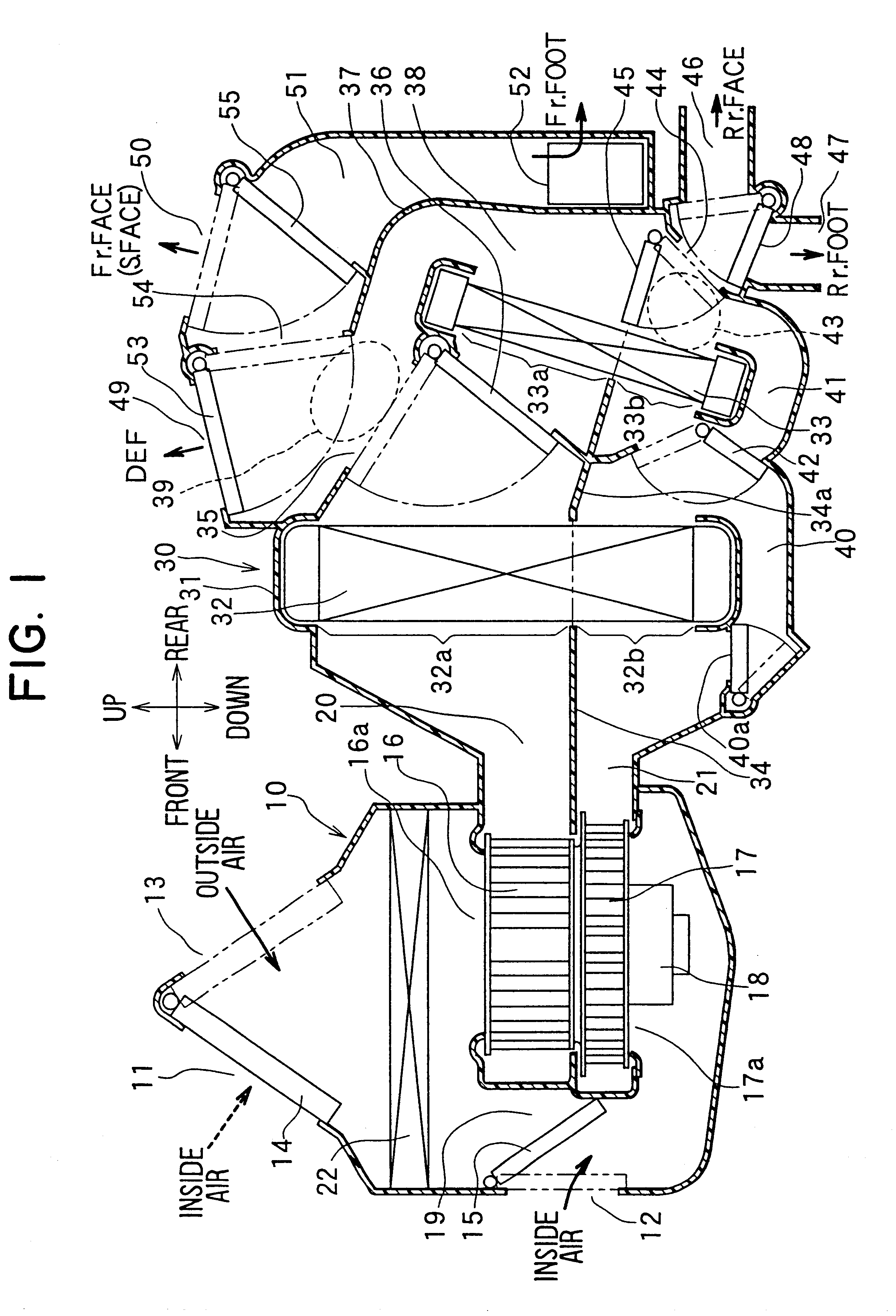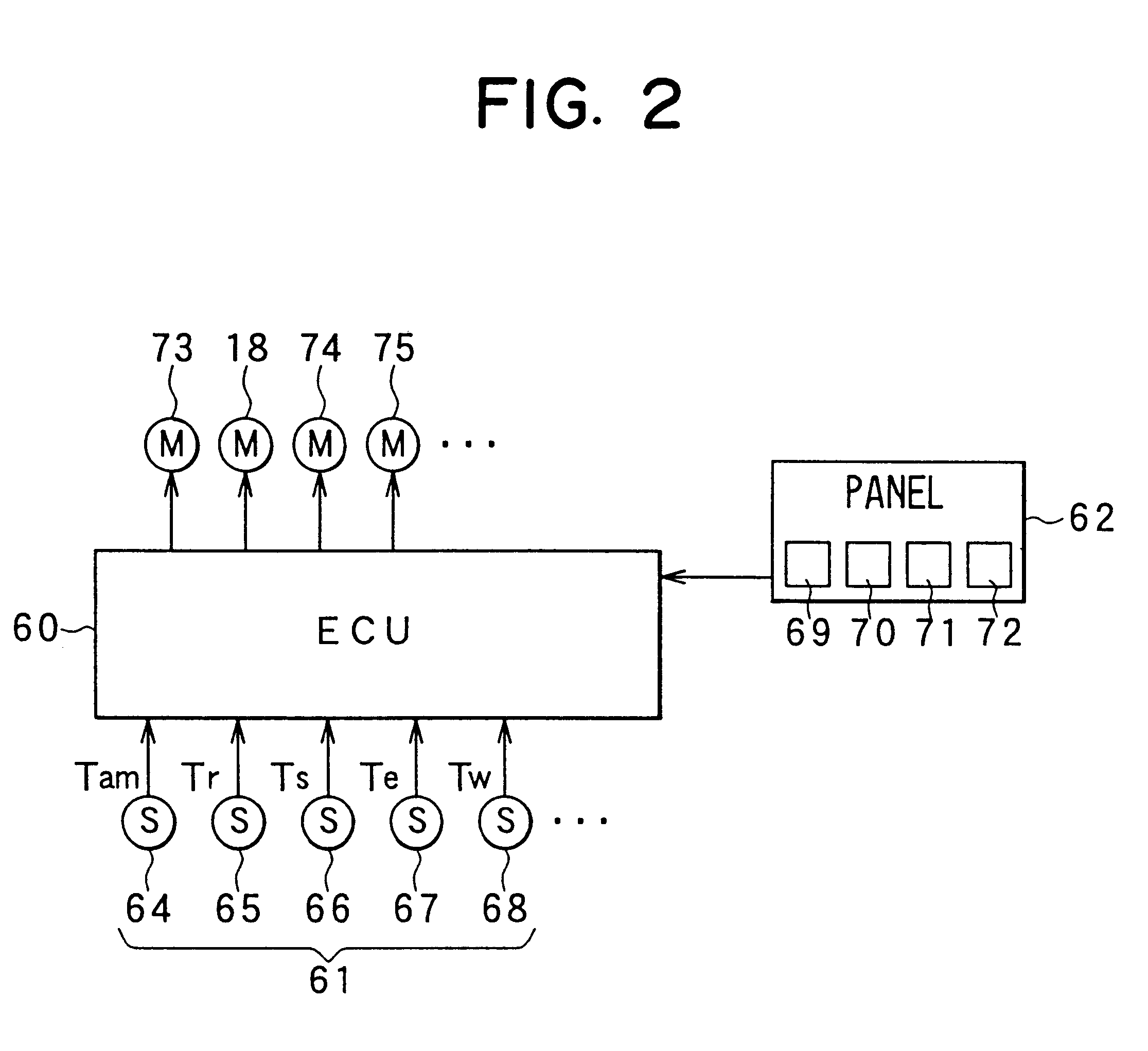Vehicle air conditioner
a technology for air conditioners and vehicles, applied in vehicle components, vehicle heating/cooling devices, railway heating/cooling, etc., can solve the problems of increased pressure loss, reduced air flow toward the rear seat side, and increased heat loss in the rear foot du
- Summary
- Abstract
- Description
- Claims
- Application Information
AI Technical Summary
Benefits of technology
Problems solved by technology
Method used
Image
Examples
first embodiment
In the above-described first embodiment, the rear air-outlet mode door 48 can be operatively linked with the front air-outlet mode doors 53, 55 while the front air mixing door 36 is operatively linked with the rear air mixing door 42, so that a door driving mechanism can be made simple. In this case, the opening degree of the rear air mixing door 42 is corrected relative to the opening degree of the front air mixing door 38. Therefore, heat loss generated in the rear duct can be canceled.
For example, during the foot mode, the opening degree of the rear air mixing door 42 is corrected to a high-temperature side relative to the opening degree of the front air mixing door 36, so that a decrease of air temperature blown toward the rear foot area, due to the heat loss in the rear duct, is restricted. Further, during the face mode, the opening degree of the rear air mixing door 42 is corrected to low-temperature side relative to the opening degree of the front air mixing door 36, so that ...
second embodiment
In the second air passage 21, by adjusting the opening degree of the evaporator bypass door 40a, a ratio between an amount of cool air passing through the lower part 32b of the evaporator 32 and non-cooled air (i.e., sucked air of the blower unit) passing through the evaporator bypass passage 40 is adjusted, so that the temperature of air blown from the rear face opening 46 is adjusted. In the second air passage 21, cool air from the lower part 32b of the evaporator 32 and non-cooled air from the evaporator bypass passage 40 are mixed in an air mixing portion 80, and the mixed air approximately linearly flows from the air mixing portion 80 toward the rear face opening 46 through the rear bypass passage 41. Therefore, air blown toward the rear face opening 46 has a small pressure loss, and the air amount blowing toward the rear seat side from the rear face opening 46 is increased. Thus, in the second embodiment, cooling capacity for the rear seat side of the passenger compartment is ...
third embodiment
In the third embodiment, during the face mode, the evaporator bypass door 40a is operated to the chain line position in FIG. 8 to fully close the evaporator bypass passage 40. Therefore, air blown by the second fan 17 in the second air passage 21 passes through a lower part of the evaporator 32 to be cooled and is blown toward the front air mixing portion 39. Thus, cooling performance for the front seat side of the passenger compartment is improved.
Further, during the defroster mode, the rear door 45 is operated to the chain line position in FIG. 8 to fully close the rear foot opening 47, so that the defrosting performance for the windshield is improved as described in the first embodiment. In the third embodiment, the other portions are similar to those in the above-described first embodiment.
A fourth preferred embodiment of the present invention will be now described with reference to FIGS. 9-14. In the above-described first embodiment, during the double layer flow mode, inside ai...
PUM
 Login to View More
Login to View More Abstract
Description
Claims
Application Information
 Login to View More
Login to View More - R&D
- Intellectual Property
- Life Sciences
- Materials
- Tech Scout
- Unparalleled Data Quality
- Higher Quality Content
- 60% Fewer Hallucinations
Browse by: Latest US Patents, China's latest patents, Technical Efficacy Thesaurus, Application Domain, Technology Topic, Popular Technical Reports.
© 2025 PatSnap. All rights reserved.Legal|Privacy policy|Modern Slavery Act Transparency Statement|Sitemap|About US| Contact US: help@patsnap.com



